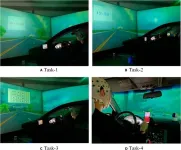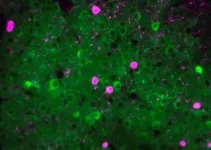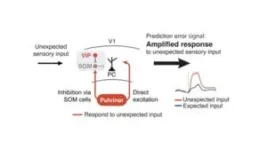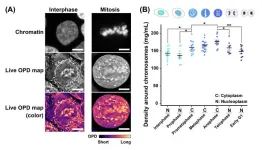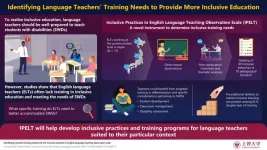Augmented recognition of distracted driving state based on electrophysiological analysis of brain network
2024-08-28
(Press-News.org)
A research paper by scientists at Beijing Jiaotong University proposed an electrophysiological analysis-based brain network method for the augmented recognition of different types of distractions during driving.
The new research paper, published on Jul. 04 in the journal Cyborg and Bionic Systems, designed and conducted a simulated experiment comprising 4 distracted driving subtasks. Three connectivity indices, including both linear and nonlinear synchronization measures, were chosen to construct the brain network. By computing connectivity strengths and topological features, we explored the potential relationship between brain network configurations and states of driver distraction.
Driver distractions, such as cognitive processing and visual disruptions during driving, lead to distinct alterations in the electroencephalogram (EEG) signals and the extracted brain networks. We designed and conducted a simulated experiment comprising 4 distracted driving subtasks. Three connectivity indices, including both linear and nonlinear synchronization measures, were chosen to construct the brain network. “By computing connectivity strengths and topological features, we explored the potential relationship between brain network configurations and states of driver distraction.” explained study author Wei Guan, a professor at Beijing Jiaotong University. Statistical analysis of network features indicates substantial differences between normal and distracted states, suggesting a reconfiguration of the brain network under distracted conditions. Different brain network features and their combinations are fed into varied machine learning classifiers to recognize the distracted driving states. The results indicate that XGBoost demonstrates superior adaptability, outperforming other classifiers across all selected network features. For individual networks, features constructed using synchronization likelihood (SL) achieved the highest accuracy in distinguishing between cognitive and visual distraction. The optimal feature set from 3 network combinations achieves an accuracy of 95.1% for binary classification and 88.3% for ternary classification of normal, cognitively distracted, and visually distracted driving states. “The proposed method could accomplish the augmented recognition of distracted driving states and may serve as a valuable tool for further optimizing driver assistance systems with distraction control strategies, as well as a reference for future research on the brain-computer interface in autonomous driving.” said study authors.
The aim of this study was to establish an augmented recognition framework of distracted driving states by leveraging varied synchronization indicators in brain networks. “A simulated carfollowing experiment containing 4 distraction subtasks was designed to encompass the cognitive distraction and visual distraction states. Tree connectivity indices including synchronization likelihood (SL), phase locking value (PLV), and coherence indicator were selected to construct functional brain networks. The connectivity strength as well as 4 global topological features were calculated to explore the potential relationship between the configuration of the brain network and the occurrence of driving distraction. Subsequently, the machine learning classifiers were trained and implemented to recognize the different distracted driving states based on brain network features.” said Geqi Qi.
The main contributions of the paper are listed as follows: a. The configuration of the functional brain network during distracted driving is constructed through electrophysiological analysis using 3 synchronization indicators as network edges and 4 global topological features as network properties. b. The performance of different synchronization indicators in brain networks is compared and the SL presents optimal recognition capability in distinguishing between normal and distracted driving states using single brain network knowledge. c. The augmented framework of recognizing normal, visual distraction, and cognitive distraction states is proposed, and the best classification performance is achieved by utilizing the combined global topological features of the 3 varied brain networks characterized by different synchronization indicators. Totally, such electrophysiological analysis of the brain network will provide a foundation for the advancement of driver assistance systems with distraction control strategies and the development of brain-controlled systems, in both conventional human driving scenarios and autonomous driving contexts.
Authors of the paper include Geqi Qi, Rui Liu, Wei Guan, Ailing Huang
This work was supported by the the National Natural Science Foundation of China (grant nos. 72101014 and 72271018) and the Key Laboratory of Brain-Machine Intelligence for Information Behavior, Ministry of Education, China (2023JYBKFKT009).
The paper, “Augmented Recognition of Distracted Driving State Based on Electrophysiological Analysis of Brain Network” was published in the journal Cyborg and Bionic Systems on Jul 04, 2024, at DOI: 10.34133/cbsystems.0130.
END
ELSE PRESS RELEASES FROM THIS DATE:
2024-08-28
Researchers at Kanazawa University report in eLife on deciphering the actin structure-dependent preferential cooperative binding of cofilin.
The actin filament is a double-stranded helical structure formed by intertwining two long-pitch helices, with the distance between crossover points, known as the half helical pitch (HHP), being about 36 nm. A canonical half helix consists of 13 actin protomers, or 6.5 protomer pairs, resulting in a mean axial distance (MAD) of 5.5 nm between two adjacent protomers ...
2024-08-28
A team of scientists studying cell division developed a special light microscopy system and used it to analyze the molecular density of cellular environments. Their results provide a novel insight into mitotic chromosome condensation in living human cells.
Their work is published in the journal Proceedings of the National Academy of Sciences (PNAS) on August 27, 2024.
DOI:https://doi.org/10.1073/pnas.2403153121
To carry out their study, the team developed an orientation-independent-differential interference contrast (OI-DIC) microscopy system combined with a confocal ...
2024-08-28
East Hanover, NJ – August 28, 2024 – Young people with disabilities aged 16 to 24 had high school enrollment rates nearly identical to their non-disabled peers, but significantly fewer held jobs during this time. Meanwhile, college students with disabilities were less likely to be enrolled but were slightly more likely to be employed, possibly benefiting from the rise of remote work opportunities in the post-COVID era, according to data shared during the according to last Friday’s National Trends in Disability ...
2024-08-28
Female sea turtles lay their eggs, cover the nest with sand and then return to the ocean, leaving them to develop and hatch on their own. From nest predators to rising temperatures, odds of survival are bleak. Once hatched and in the ocean, about one in 1,000 make it to adulthood.
Hatchling size matters. Larger hatchlings, which move faster, are more likely to survive because they spend less time on risky beach sands.
Research shows that both air and sand temperatures crucially impact sea turtle hatchlings. Cooler temperatures produce larger, heavier hatchlings with more males, while warmer temperatures ...
2024-08-28
Cancer cells have voracious appetites. And there are certain nutrients they can’t live without. Scientists have long hoped they might stop tumors in their tracks by cutting off an essential part of cancer cells’ diet. But these cells are crafty and often find a new way to get what they need. How? By reprogramming their metabolism and switching to backup food supplies.
Now, Cold Spring Harbor Laboratory (CSHL) Assistant Professor Michael Lukey has found a way to deprive cancer cells of both a vital nutrient and their backup supply. In lab experiments with breast cancer cells, patient-derived tissue models, and mice, ...
2024-08-28
Access to education is recognized as one of the pillars of sustainability; it is certainly a necessary foundation if we are to build a better world for ourselves and future generations. However, education needs to be not only accessible, but also inclusive. That is, it should extend to people with all kinds of disabilities and suit their particular needs.
According to a recent report by the World Health Organization, it is estimated that a striking 16% of the world’s population lives with some form of disability. Considering there are about 1.5 billion English language teachers (ELTs) worldwide, there is a great need for adequately trained ELTs that can teach students with ...
2024-08-28
Healthcare is undoubtedly crucial for everyone. As individuals age, the risk for health issues and related expenses increases. Consequently, many countries have universal healthcare systems, primarily funded through tax and insurance, to ensure access to essential healthcare services. However, this system is under a heavy fiscal burden since the aging population has increased manyfold, owing to decreasing fertility rates and increasing life span. To sustain the system, governments must face the herculean task of persuading citizens to contribute more to health insurance.
In a recent study, a research team consisting of Associate ...
2024-08-28
SAN ANTONIO, TEXAS — One master’s program. Two universities. Two countries. Two degrees. Students from UTSA and Tecnológico de Monterrey (Tec de Monterrey) in Mexico are swapping campuses, as the two universities jointly launch a unique new degree program this fall.
The collaborative program offers students the distinctive opportunity to take high-quality courses at both institutions and earn two degrees: a Master of Science in Information Technology with a concentration in cybersecurity from UTSA and a Master in Cybersecurity from Tec de Monterrey.
The program will enable students to advance their cybersecurity ...
2024-08-28
Type 2 diabetes and prediabetes are associated with accelerated brain ageing, according to a new study from Karolinska Institutet in Sweden published in the journal Diabetes Care. The good news is that this may be counteracted by a healthy lifestyle.
Type 2 diabetes is a known risk factor for dementia, but it is unclear how diabetes and its early stages, known as prediabetes, affect brain ageing in people without dementia. Now, a comprehensive brain imaging study shows that both diabetes and prediabetes can be linked to accelerated brain ageing.
The study included more than 31,000 people between 40 and ...
2024-08-28
New research suggests that epigenetic markers in the blood could be useful for understanding dementia risk.
Two linked papers from the University of Exeter and Maastricht University have together progressed research to show the potential for DNA methylation, an epigenetic marker, in understanding how genetics and lifestyle factors influence dementia risk.
DNA methylation is a chemical tag added to DNA, which can turn genes on and off. Genetic and lifestyle factors can alter the levels of the DNA methylation tag on genes, with some of these factors already known to increase the risk of developing dementia. By assessing DNA methylation this can help scientists ...
LAST 30 PRESS RELEASES:
[Press-News.org] Augmented recognition of distracted driving state based on electrophysiological analysis of brain network
